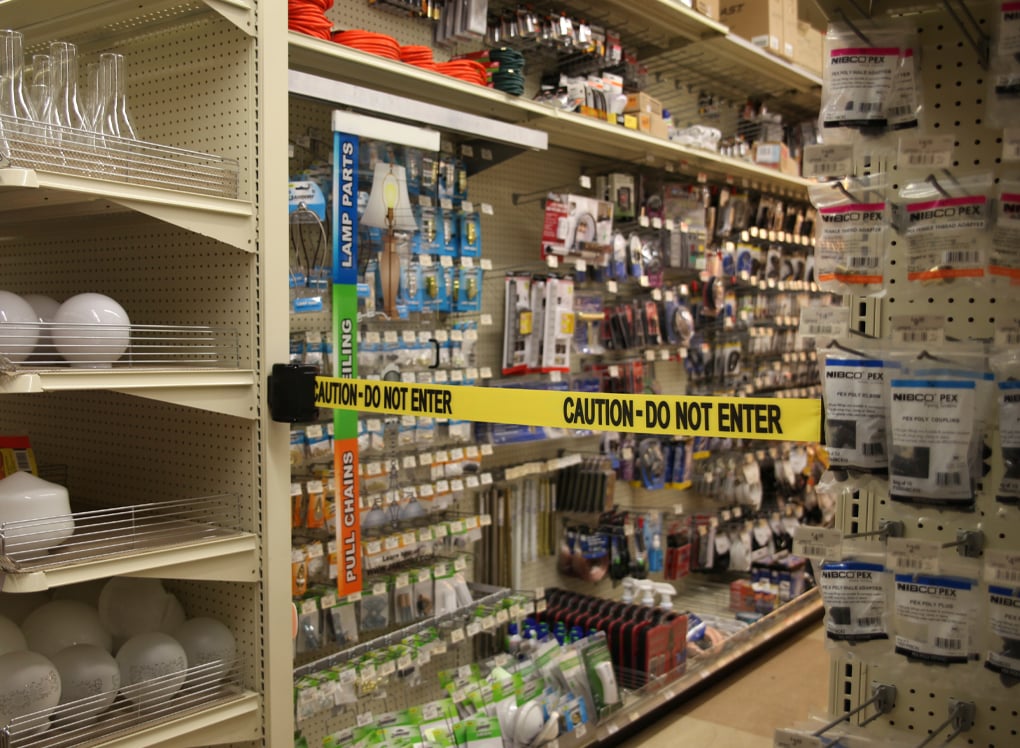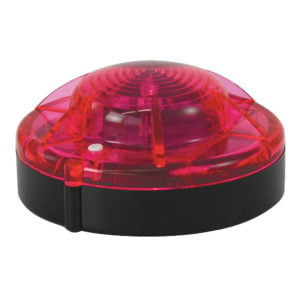Picture this - there is a giant crack in the sidewalk in front of your office. It's nearly impossible to see but very easy to trip on. No sign, barrier, or other warning message is utilized to warn people of the potential tripping hazard. Completely unaware of the crack, you stroll into the office one morning. Just as you're calling out a friendly hello to a co-worker across the parking lot, your heel catches in the right spot and Wham! Before you know it, you've hit the ground like a ton of bricks. Not a great start to the morning.
Retelling your harrowing tale to other employees in the break-room, no one is surprised. "Oh, I've fallen on that spot a million times" someone chimes in and soon everyone is nodding in agreement. You realize half the office has tripped as a result of the sidewalk hazard - and it all could have been avoided with clear communication.
Communication barriers are your first line of defense in accident prevention
It's nearly impossible to prevent an accident from happening if people are unaware that there is a potential hazard to begin with. Communication is key. Safety and hazard communication barriers are absolutely crucial to keeping workers and the public informed about possible dangers.
How to Choose the Right Barrier
Once you've made the decision that your facility is in needs of safety barriers, your next step is choosing the right one. Let's breakdown some key factors to keep in mind when making your selection.
Location, Location, location
With belt barriers, location is everything. What's appropriate for an indoor, office doorway may not work great outdoors on a construction site. Before purchasing any barriers, it's important to really think about the location where they are needed and choose accordingly.
Barriers for predominantly outdoor use need to be able to withstand extreme weather conditions without rusting, corroding, or falling apart. Ideally, a well-made outdoor barrier should have the potential to be in use for decades before it's in need of repair or replacement.
If your location is an indoor shopping center, airport, bank, or other retail environment, you'll want something more aesthetically pleasing and will require something less robust. Which isn't to say you should choose form over function. Safety barriers for retail environments require the right mix of both style and durability.
Is your location a busy indoor environment that sees a lot of foot traffic? In that case, you will still require something substantially durable. An indoor barrier should be able to withstand crowds of people, including children, without tipping over or being damaged. Check the base and post of indoor barriers for maximum stability. You're looking for a sturdy base that is strong enough to hold the barrier and a post that does not lean over when the belt is extended.
If your barrier will be used in an indoor warehouse or other industrial facility to alert worker of serious dangers, visibility should be a key factor in your choice. You'll want a barrier that is highly visible from a distance. In the case of facilities using heavy machinery, such as forklifts and boom lifts, keep in mind that drivers and workers in lifts will need an eye catching barrier to help them spot hazards.
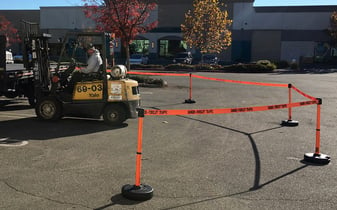
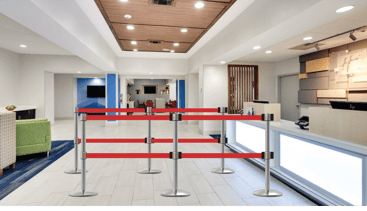
Above: An outdoor construction site and a hotel lobby have very different safety barrier needs
Don't forget about Compliance
Before spending money on a barrier, it's a good idea to ensure that it complies with the requirements set forth by OSHA. That way you are not wasting time and money on something that you find requires replacement later on. Some barriers themselves are unsafe and can present potential hazards - such as a belt that hangs on the ground creating a tripping risk, or a barrier made from flammable materials that are inappropriate for certain facilities.
Look for a barrier that is safe, highly visible, and meets any OSHA requirements pertaining to your industry.
Keep in mind that OSHA and the ANSI have outlined 10 safety colors for visual communication with specific applications for each. Look for barriers that adhere to these standard color codes.
Be flashy
The goal of a good safety barrier is to be so noticeable it's hard-to-miss. Remember, safety and hazard communication barriers are there to grab people's attention and alert them of potential danger. Size, color and the use of images all play a role in making a barrier more noticeable. Belt barriers with a larger belt width are generally easier to see.
The use of bright colors is also a key factor in visibility. Choosing a vibrant, eye-catching barrier increases visibility while helping increase people's awareness of their physical surroundings. Studies have shown that color can convey meaning faster than words. This makes color a powerful tool to utilize for safety warnings where seconds can make the difference between being injury or safety.
If you are using an image on your barrier instead of only words, make sure the image is easy to see from a distance. Often symbols that are fairly universal are better than detailed pictures. A flame image, for example, on a barrier indicating flammable chemicals may be highly effective, whereas an image of a company logo may not be the best use of valuable space.
Ease of Installation
Often belt barriers need to be set up fast. An accident, such a spill, can happen in an instant and it doesn't take long before a spill can become a fall if someone doesn't see the hazard. You'll need to be able to quickly put together a barrier without too much fuss.
Look for barriers that are light weight, while still being durable. Stanchions that breakdown are much easier to carry than rigid posts that must be carried at their full height. A cart to help you haul barriers from one end of your facility to the other can also be a great help.
Barriers shouldn't require a lengthy tutorial on how to set it up. They should be user friendly - something any employee can use safety and quickly.
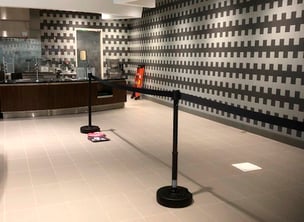
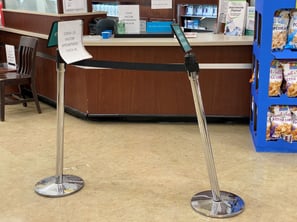
Above: Barriers with retractable stanchions are much easier to maneuver than rigid posts.
Make the Message Clear
Make sure the message is short and simple. If it isn’t easy to read and understand, it will not be accurately comprehended by employees and vistors, and therefore increases the risk of injury.
Legibility is best achieved by making sure the design of the message enhances the distinction of each individual letter. Taking advantage of the right typestyles and spacing helps viewers read the sign quickly, easily, and from a distance - the larger the lettering on a sign, the better its legibility.
Make sure the sign’s lettering is clearly distinguishable from the belt color. If you're using a bright yellow belt, for instance, black would be an excellent color choice for the message lettering as opposed to white which would be difficult to see.
Get Reliable Safety Barriers Today!
Finding the right safety belt barrier can require a little research and more than a little patience. After all, choosing a barrier is an important decision! The ability of a safety barrier to properly communicate a dangerous situation can ultimately determine whether your employees and visitors have a safe experience in your facility.
If you’re looking for a quality barrier, we can help. We offer a wide variety of retractable belt barriers, for various uses and settings - all of which are OHSA compliant. Our safety experts can assist you in finding the perfect safety products for your needs, creating a safer workplace and meeting compliance requirements.
Do you have any questions? Interested in learning more about our barriers? Contact us today and we’ll be happy to help you out!

